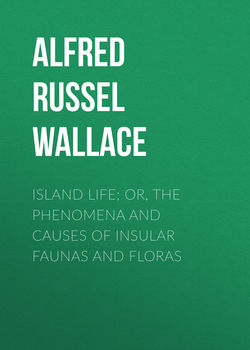Island Life; Or, The Phenomena and Causes of Insular Faunas and Floras

Реклама. ООО «ЛитРес», ИНН: 7719571260.
Оглавление
Alfred Russel Wallace. Island Life; Or, The Phenomena and Causes of Insular Faunas and Floras
PREFACE TO THE SECOND EDITION
PREFACE TO THE FIRST EDITION
PART I. THE DISPERSAL OF ORGANISMS. ITS PHENOMENA, LAWS, AND CAUSES
CHAPTER I. INTRODUCTORY
CHAPTER II. THE ELEMENTARY FACTS OF DISTRIBUTION
CHAPTER III. CLASSIFICATION OF THE FACTS OF DISTRIBUTION.—ZOOLOGICAL REGIONS
CHAPTER IV. EVOLUTION THE KEY TO DISTRIBUTION
CHAPTER V. THE POWERS OF DISPERSAL OF ANIMALS AND PLANTS
CHAPTER VI. GEOGRAPHICAL AND GEOLOGICAL CHANGES: THE PERMANENCE OF CONTINENTS
CHAPTER VII. CHANGES OF CLIMATE WHICH HAVE INFLUENCED THE DISPERSAL OF ORGANISMS: THE GLACIAL EPOCH
CHAPTER VIII. THE CAUSES OF GLACIAL EPOCHS
CHAPTER IX. ANCIENT GLACIAL EPOCHS, AND MILD CLIMATES IN THE ARCTIC REGIONS
CHAPTER X. THE EARTH'S AGE, AND THE RATE OF DEVELOPMENT OF ANIMALS AND PLANTS
PART II. INSULAR FAUNAS AND FLORAS
CHAPTER XI. THE CLASSIFICATION OF ISLANDS
CHAPTER XII. OCEANIC ISLANDS:—THE AZORES AND BERMUDA
CHAPTER XIII. THE GALAPAGOS ISLANDS
CHAPTER XIV. ST. HELENA
CHAPTER XV. THE SANDWICH ISLANDS
CHAPTER XVI. CONTINENTAL ISLANDS OF RECENT ORIGIN: GREAT BRITAIN
CHAPTER XVII. BORNEO AND JAVA
CHAPTER XVIII. JAPAN AND FORMOSA
CHAPTER XIX. ANCIENT CONTINENTAL ISLANDS: THE MADAGASCAR GROUP
CHAPTER XX. ANOMALOUS ISLANDS: CELEBES
APPENDIX TO CHAPTER XX
CHAPTER XXI. ANOMALOUS ISLANDS: NEW ZEALAND
CHAPTER XXII. THE FLORA OF NEW ZEALAND: ITS AFFINITIES AND PROBABLE ORIGIN
CHAPTER XXIII. ON THE ARCTIC ELEMENT IN SOUTH TEMPERATE FLORAS
CHAPTER XXIV. SUMMARY AND CONCLUSION
Отрывок из книги
This edition has been carefully revised throughout, and owing to the great increase to our knowledge of the Natural History of some of the islands during the last twelve years considerable additions or alterations have been required. The more important of these changes are the following:—
Chapter VII. The account of the migrations of animals and plants during and since the Glacial Epoch, has been modified to accord with newer information.
.....
A creature which has been thus modified in important characters will be a new type, specially adapted to fill a new place in the economy of nature. It will almost certainly have arisen from an extensive or dominant species, because only such are sufficiently rich in individuals to afford an ample supply of the necessary variations, and it will inherit the vigour of constitution and adaptability to a wide range of conditions which gave success to its ancestors. It will therefore have every chance in its favour in the struggle for existence; it may spread widely and displace many of its nearest allies, and in doing so will itself become modified superficially and become the parent of a number of subordinate species. It will now have become a dominant genus, occupying an entire continent, or perhaps even two or more continents, spreading in every direction till it comes in contact with competing forms better adapted to the different environments. Such a genus may continue to exist during long geological epochs; but the time will generally come when either physical changes, or competing forms, or new enemies are too much for it, and it begins to lose its supremacy. First one then another of its component species will dwindle away and become extinct, till at last only a few species remain. Sometimes these soon follow the others and the whole genus dies out, as thousands of genera have died out during the long course of the earth's life-history; but it will also sometimes happen that a few species will continue to maintain themselves in areas where they are removed from the influences that exterminated their fellows.
Cause of the Extinction of Species.—There is good reason to believe that the most effective agent in the extinction of species is the pressure of other species, whether as enemies or merely as competitors. If therefore any portion of the earth is cut off from the influx of new or more highly organised animals, we may there expect to find the remains of groups which have elsewhere become extinct. In islands which have been long separated from their parent continents these conditions are exactly fulfilled, and it is in such places that we find the most striking examples of the preservation of fragments of primeval groups of animals, often widely separated from each other, owing to their having been preserved at remote portions of the area of the once widespread parental group. There are many other ways in which portions of dying out groups may be saved. Nocturnal or subterranean modes of life may save a species from enemies or competitors, and many of the ancient types still existing have such habits. The dense gloom of equatorial forests also affords means of concealment and protection, and we sometimes find in such localities a few remnants of low types in the midst of a general assemblage of higher forms. Some of the most ancient types now living inhabit caves like the Proteus, or bury themselves in mud like the Lepidosiren, or in sand like the Amphioxus, the last being the most primitive of all vertebrates; while the Galeopithecus and Tarsius of the Malay islands and the potto of West Africa, survive amid the higher mammalia of the Asiatic and African continents owing to their nocturnal habits and concealment in the densest forests.
.....